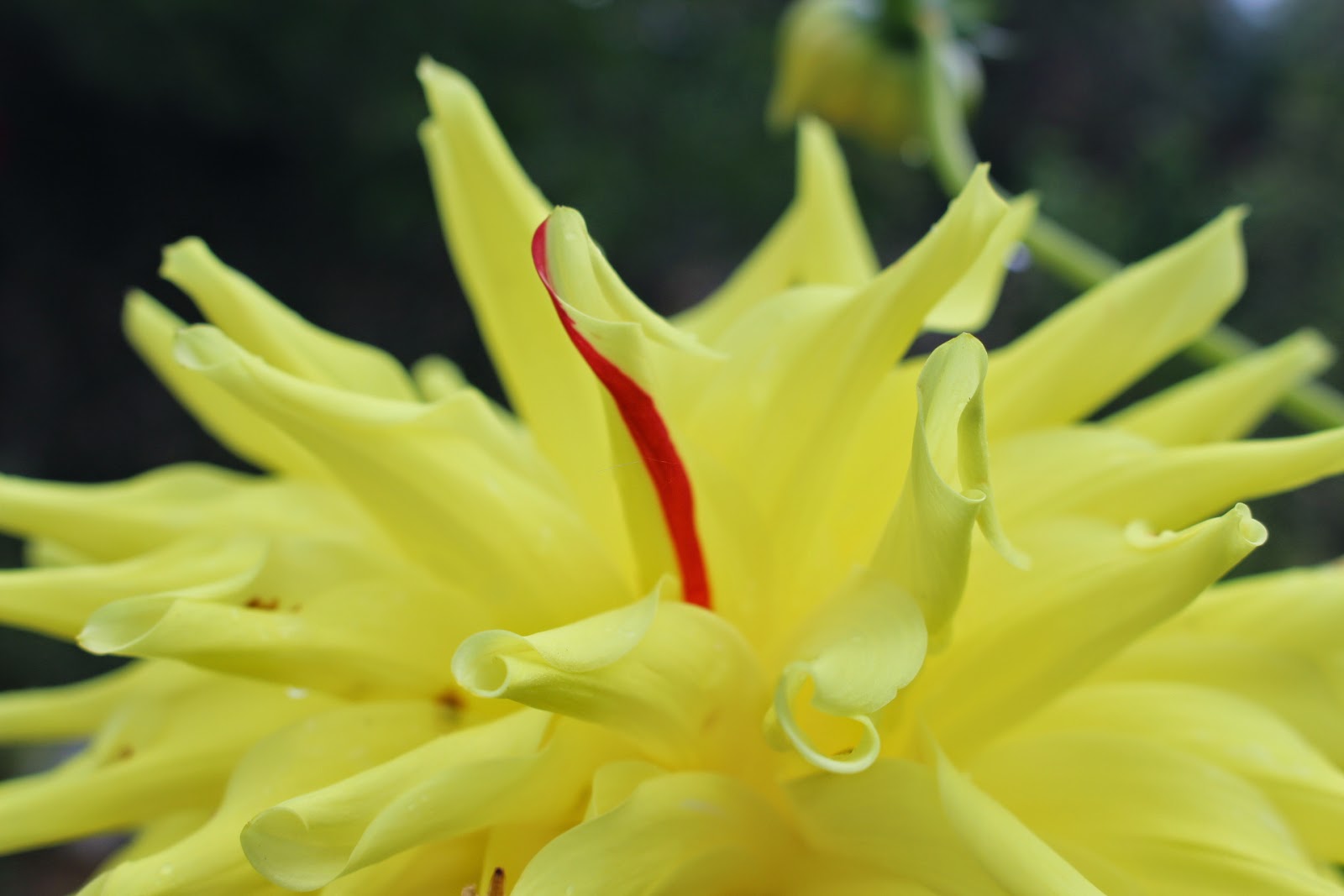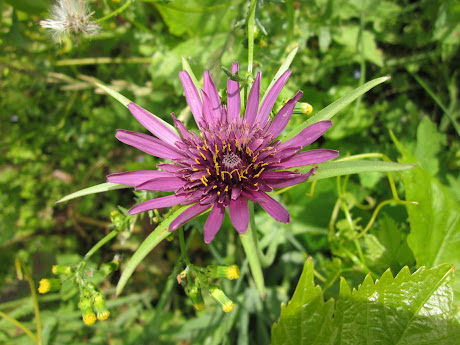 |
| My daffy dahlia - posing for its photo in the large terrace bed |
Whilst I was out in the garden last week, I noticed something slightly different in one of my bright yellow "dinner plate" dahlias. This plant is in its third season here and it's the first time I've seen a streak of red on any of the petals.
Just one flower is affected, so what's going on?
Four possible reasons spring to mind: environmental impact, genetic mutation, reversion, or a reaction to a virus.
Environmental impact
I wrote about how environmental factors affected
My Crazy Petunias last year. I found the Crazytunias I grew were sensitive to light and temperature and this in turn affected their flower colouration. I also uncovered a number of other examples (like my
Salvia 'Hot Lips') which can differ in response to a number of environmental factors or stress. I don't think that's happening in this case as it's just a single streak of red and it hasn't happened before.
It's all in the genes?
Genetic mutation which gives rise to a different looking plant aka a 'sport' is a well-known way of obtaining new plants. I've already seen a couple of these here at
VP Gardens, most notably my
Mystery Clematis. It could be a sport this time, but somehow I don't think there's enough of a variation for this to be my favoured explanation.
Going back to mum or dad
Reversion is where a plant goes back to a different form found in its parentage. The most well-known example is where variegated plants revert to pure green leaves. This is happening currently with some of my
Euonymus shrubs in the front garden. It could explain what's happening here, but without knowing this particular dahlia's breeding, I have no way of knowing whether there is any red in its genetic parentage.
Give them a break
Virus infections giving rise to
colour breaks in flowers are very well known, particularly with tulips. They can produce some spectacularly mottled and striped flowers resulting from infection by the
Tulip breaking virus. It was these variations which helped fuel "Tulip mania" in Europe during the 17th Century. I've found
one reference to this also happening with dahlias, so this possibility - like reversion - needs further research.
Next steps
In the meantime, I'll apply my
Dahlia Duvet as usual this winter and hope I can continue with my observations next year. At the moment I'm tending towards reversion as the cause as the difference is so limited on one bloom. One of my large variegated
Euonymus shrubs has just a single small branch which has reverted. If it was a virus, I would expect a more dramatic change, unless the infection is very light.
Quite often with a virus, infected plants get steadily weaker until they no longer bloom. This is what happened to some of the popular tulip varieties in the past. So next year I'll look for more red streaks on blooms and/or any signs of weakening of the plant.
What a living botany lesson my garden is turning out to be. There's always something new to observe and learn, so I'm adding a new
Botany label to the blog - to gather together my lessons from
VP Gardens.
Update 23/10
I popped into the RHS
Shades of Autumn show in London yesterday to ask their advisory service about my dahlia. They say it's a
chimera, i.e. material which is genetically distinct from the rest of the plant. Apparently this phenomenon is often seen late on in the season in plants like my dahlia, and it's usually a reaction to environmental factors such as temperature fluctuation.
There are other ways in which chimeras occur, most of them linked with a genetic mutations of some kind. Many of our variegated plants are chimera, with the paler foliage genetically distinct and living alongside the green. As the pale foliage has no chlorophyll, it is dependent on the green foliage for its survival.
Some grafted plants are chimera too and that's the exception to the cause being genetic. It's great to have got to the bottom of the cause so quickly and to have something so interesting happen at VP Gardens.











Hopefully it is just reversion but fascinating nevertheless to have such oddities pop out every so often.
ReplyDeleteI love it when this kind of thing happens. It adds another dimension to my little patch of a garden :)
DeleteWhat an interesting post. Flighty xx
ReplyDeleteThanks Flighty :) xx
DeleteIntriguing isn't it, it'll be interesting to see what happens next year.
ReplyDeleteIndeed :) I feel a bit like a detective - I shall put on my deerstalker next year and investigate ;)
DeleteInteresting to see your dahlia, I have one that developed stripes on every petal, in its 3rd year! But it is called ‘Striped Vulcan’ – and was uniform orange the first 2 years so I suppose mine has not reverted, it’s just finally found its stripes :-) Dahlias are funny and interesting and beautiful, aren’t they? Incidentally, I had a look at your ‘Dahlia Duvet’ – here in my London garden my dahlias have spent the last up to 10 years in the ground, with no duvet, just a drizzle of bark mulch. That’s all. I have not lost one single dahlia yet.
ReplyDeleteThat's interesting Helene - I wonder of mine will do the same!
DeleteI guess you can do that in London and get away with it. We don't have so much of a heat island effect here and my soil is clay, so I'll stick with the duvet. However, I did have a Bishop of Landaff survive for about 3 years on the allotment with no covering except the weeds, so it can be done here too sometimes!
Oh how intriguing VP. Might be worth contacting the RHS advisory service to see if they have any other suggestions. I've never seen this occur on any of my dahlias yet ...... :)
ReplyDeleteWhat a timely comment Anna - I'm in London tomorrow which coincides with the latest RHS show. I was thinking of showing them the photo to see what they make of it :)
DeleteVery pretty with interesting red streak. I hope it is not a sign of trouble.
ReplyDeleteHave a wonderful week!
Lea
Thanks Lea :)
Delete